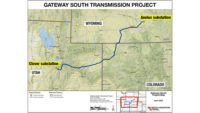While the Electric Reliability Council did an initial system plan—designating in general where the lines will go—the transmission service providers and their engineers have had additional tasks such as foundation design for transmission towers and more electrical engineering needed for the substations, according to Randy Pollock, CREZ project manager for Power Engineers. The companies also have had to route around property at the request of owners, and in some cases have had to design and install monopoles instead of transmission towers at the request of local residents.
The work itself, Pollock says, is straightforward. "Probably what is most challenging is the amount of work in a compressed time frame," he notes.
The Lower Colorado River Authority has perhaps one of the most challenging terrains across the CREZ system—Texas Hill country. Beyond the normal difficulties of building anything in the canyons and hills of West Texas, the utility commission is requiring monopole construction in scenic areas for aesthetic reasons.
Stuart Nelson, authority manager of transmission asset development, says it is always difficult to build in such terrain, but constructing a monopole, which requires a larger foundation and more material, creates additional challenges. Monopoles are much more effective in wide open country while traditional lattice towers are far more efficient from a materials standpoint. "There's much less infrastructure and equipment to get up those hills," he says.






Post a comment to this article
Report Abusive Comment